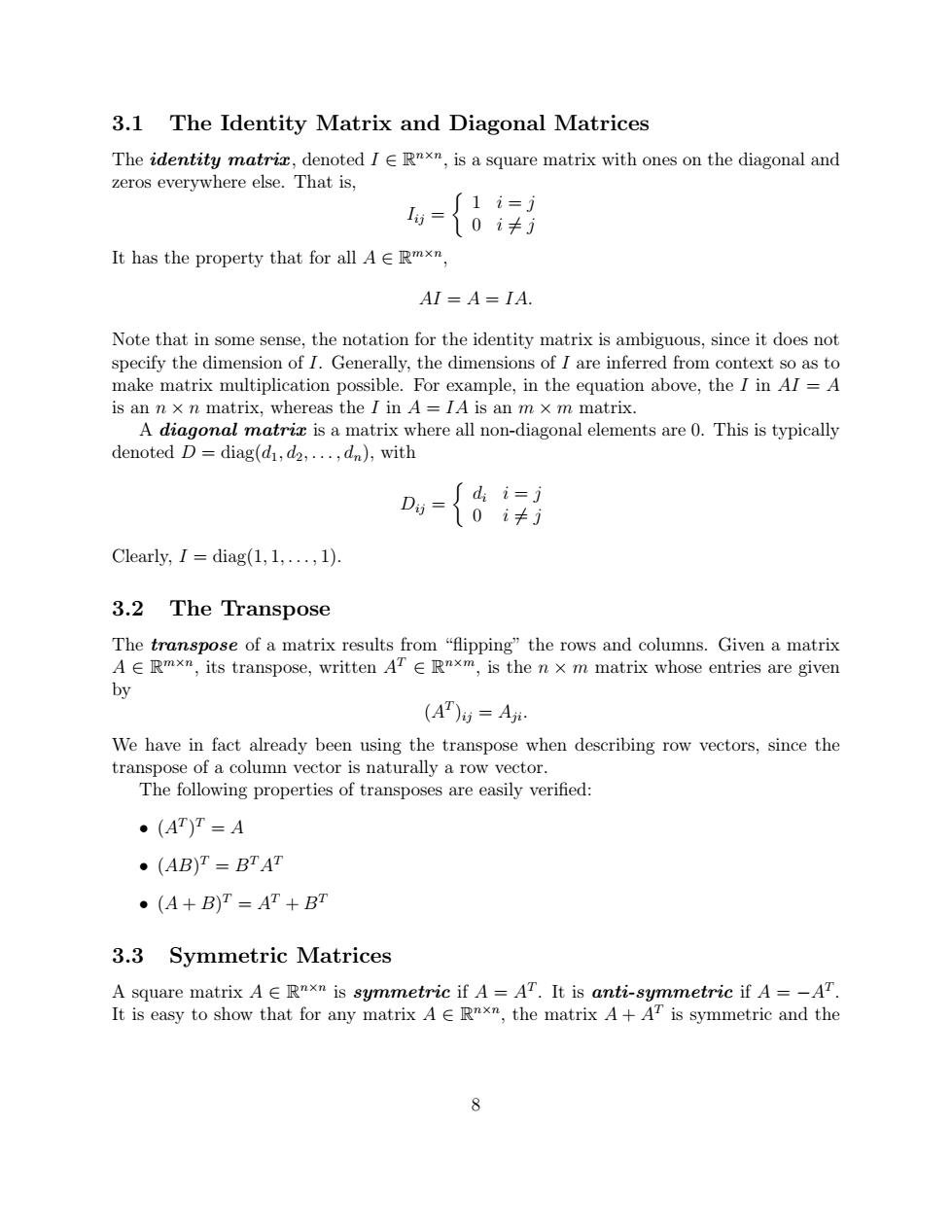正在加载图片...

3.1 The Identity Matrix and Diagonal Matrices The identity matric,denoted I E Rnxr,is a square matrix with ones on the diagonal and zeros everywhere else.That is, (1i=j ={0i+j It has the property that for all ARmxn, AI=A=IA. Note that in some sense,the notation for the identity matrix is ambiguous,since it does not specify the dimension of I.Generally,the dimensions of I are inferred from context so as to make matrix multiplication possible.For example,in the equation above,the I in Al=A is an n x n matrix,whereas the I in A=IA is an m x m matrix. A diagonal matrin is a matrix where all non-diagonal elements are 0.This is typically denoted D diag(di,d2,...,dn),with di i=j 0i≠j Clearly,I diag(1,1,...,1). 3.2 The Transpose The transpose of a matrix results from "flipping"the rows and columns.Given a matrix A E Rmxr,its transpose,written ATE Rnxm,is the n x m matrix whose entries are given by (AT)i=Aji We have in fact already been using the transpose when describing row vectors,since the transpose of a column vector is naturally a row vector. The following properties of transposes are easily verified: ·(AT)T=A ·(AB)T=BTAT ·(A+B)T=AT+BT 3.3 Symmetric Matrices A square matrix AE Rnxn is symmetric if A=AT.It is anti-symmetric if A=-AT. It is easy to show that for any matrix A E R"x",the matrix A+AT is symmetric and the 83.1 The Identity Matrix and Diagonal Matrices The identity matrix, denoted I ∈ R n×n , is a square matrix with ones on the diagonal and zeros everywhere else. That is, Iij = 1 i = j 0 i 6= j It has the property that for all A ∈ R m×n , AI = A = IA. Note that in some sense, the notation for the identity matrix is ambiguous, since it does not specify the dimension of I. Generally, the dimensions of I are inferred from context so as to make matrix multiplication possible. For example, in the equation above, the I in AI = A is an n × n matrix, whereas the I in A = IA is an m × m matrix. A diagonal matrix is a matrix where all non-diagonal elements are 0. This is typically denoted D = diag(d1, d2, . . . , dn), with Dij = di i = j 0 i 6= j Clearly, I = diag(1, 1, . . . , 1). 3.2 The Transpose The transpose of a matrix results from “flipping” the rows and columns. Given a matrix A ∈ R m×n , its transpose, written AT ∈ R n×m, is the n × m matrix whose entries are given by (A T )ij = Aji. We have in fact already been using the transpose when describing row vectors, since the transpose of a column vector is naturally a row vector. The following properties of transposes are easily verified: • (AT ) T = A • (AB) T = BTAT • (A + B) T = AT + BT 3.3 Symmetric Matrices A square matrix A ∈ R n×n is symmetric if A = AT . It is anti-symmetric if A = −AT . It is easy to show that for any matrix A ∈ R n×n , the matrix A + AT is symmetric and the 8